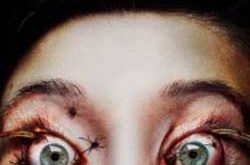In 1885, a female doctor helping a group of people with their phobias becomes embroiled in a murder mystery surrounding a patient that may or may not be a vampire.
REVIEW:
Remember when vampires were feared more than fantasized about? Though the resurgence of our fanged friends has been a welcome one amidst the relentless onslaught of zombies, slashers and grainy footage of things going bump in the night, it hasn’t exactly been accompanied by a thundering roar. More like a grade school note with “Do you like me? Circle one: Yes or No” hastily scrawled upon it. Pardon the hilarious and completely original pun I’m fairly certain no other critic has ever uttered or typed, but today’s vamp flicks lack bite.
Hold for laughs . . . and moving on.
On the other hand, it doesn’t require buckets of blood to pique the interest in this arena of horror. From the Texas production company Gravitas Ventures, our latest offering is one of the more ambitious independent attempts to put a new spin on the legend that has emerged in quite a spell. Using psychology as a backdrop and questioning the very existence of vampires as a central theme, “Phobia” sets its sights high whilst simultaneously succumbing to the same terminal case of the cutsies that plagues the most mundanely mainstream of its ilk.
Set in 1885 and globetrotting between France and California, “Phobia” opens with the same bit of pre-credit exposition we’ve grown to expect and could easily be summed up in five words at nearly any other point in the first third. This trope is quickly evolving into an indication of lazy film making, as in most cases (this one being an example) where it serves only to start things off with a taste of murder and/or mayhem, yet promises nothing. Our protagonist Dr. Lesley Parker is afraid of the dark. Enough said.
Well-played by genre vet Erica Leerhsen (her nude pole dance was a lonely highlight in “Blair Witch 2: Book of Shadows”), Lesley is a fascinating main character. After earning her psychology degree in the states, she dons her best Glenn Close Albert Nobbs drag attire and heads to Paris to study under famed hypnotist Dr. Charcot (Michael Crabtree). She would like to utilize hypnotism in treatment of individuals with phobias resulting from repressed childhood trauma. She explains this to fellow student Sigmund Freud (Matt Moore, having fun with it), who believes her approach may prove beneficial to Charcot’s latest head case.
“What in the holy hell does this have to do with vampires?” you may ask. The patient in question is Val Drakul (Chase Ryan Jeffery), a descendent of you-know-the-dude who claims to be a blood sucker of lore. Perhaps this direct connection propels his delusions, but it’s more likely due to his blackouts that coincide with a series of grisly murders, occurring first at his father’s estate and now in France upon his arrival. The victims all bear the same brutal throat lacerations, and Val is convinced he is the nocturnal culprit.
Upon meeting, Lesley explains her process to Val and persuades him that his belief is merely a paranoia resulting from memories buried deep in his psyche. In layman’s terms, he’s bananas. Finding himself attracted to her (imagine his relief when he discovers she’s a chick), he agrees to accompany her to San Francisco for extensive treatment sessions. Tagging along are Val’s cousins Guy and Marcia (Jonathan Brooks, Tiffany Lonsdale), who wish to rid the latter of her claustrophobia.
They set up shop in the sprawling manor of Annabel Lee (Carolyn Wickwire), and aged widow who sleeps in a coffin and hasn’t left the house in fifteen years. Others burdened with phobias (the most offbeat being Aichmophobia, the fear of sharp objects) arrive, and a now-girlied up Lesley explains her process, which employs what was unheard of in the 19th century but we’ve come to know today as group therapy.
Observed by the undercover Inspector Casey (Matthew Tompkins) posing as one of Charcot’s associates, our gang begins the journey to mental health. The endeavor sails swimmingly until Marcia reluctantly consents to spend ten minutes in Annabel’s coffin. Apparently, the concept of “baby steps” wasn’t common practice then either. Alone in the room, Lesley and Marcia are soon trapped in their own personal nightmares as the lights go out and the latch breaks on the casket, sealing it and cutting off the air supply. Before the others can intervene, she perishes from asphyxiation.
As fingers are pointed in all directions (most of them at Val), Casey suggests they perform a séance, and entreat the spirits of the house to provide answers. Lesley voices the exact sentiment of yours truly by pleading with them not to engage in such nonsense, but they proceed with the ritual regardless of her and my objections. The results yield less success than the coffin fiasco, resulting in a patient with Acrophobia leaping through the window to her death.
Director Jon Keeyes and screenwriter Anne Gibson move the narrative at a brisk pace from that point, as Plot Twist Killer #1 is revealed and the action shifts back to Paris for the first of three or four final showdowns. These ridiculously convoluted turns do nothing more than drag the endeavor into near-camp territory, evident in the reappearance of Freud to lend his necessary service of receiving an ass-stomping. The motivations of Plot Twist Killer #2 are launched straight from left field, handled clumsily upon both page and presentation.
Ironically enough, the love story between Lesley and Val retains its dignity throughout, becoming the most intriguing aspect of “Phobia” when all else unravels into the home stretch. This is due in great part to Leerhsen’s performance, finding complexity in a role that would have made the entire film a truly daunting experience in less capable hands.
She is one of many attributes the scrappy “Phobia” has going for it, though a great number fall far short of the ideals and convictions of those involved. It’s a commendable effort and never less than watchable, but unfortunately . . . say it with me . . . bites off more than it can chew. Okay, I’ll stop.
 Horror News | HNN Official Site | Horror Movies,Trailers, Reviews
Horror News | HNN Official Site | Horror Movies,Trailers, Reviews











